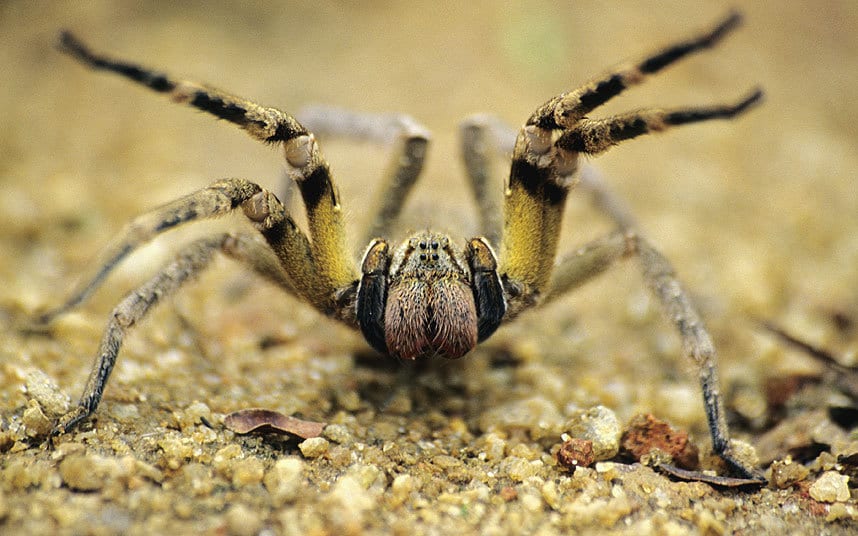Brazilian Armed Spider (Phoneutria)
A box of bananas were delivered to a pub in Bridgwater, England in 2005. Unbeknownst to the person opening the bananas, an aggressive spider was hiding in the bananas and bit him. Later on it would be identified as the venomous and speedy species Phoneutria fera (Brazilian Huntsmen) from South America.

Our topic today is about the Phoneutria species of spiders. There are 8 species, with only a few being the ones that are primarily interesting for envenomation. They all are recognizable by their defensive posture. They have a leg span of about 6 inches and have light stripes under their legs that are revealed while in the posture. When threatened, they assume a characteristic defensive position by raising their four front legs, displaying their fangs, bristling their leg spines, and moving position to continually face their threat. At this point it would be worth mentioning they can jump over a foot in distance.
 "Come at me bro." - This spider, probably.
"Come at me bro." - This spider, probably.
Phoneutria fera/Phoneutria nigriventer are the most venemous. P. fera is only in the Amazon while P. nigriventer is in Brazil, northern Argentina, and Uruguay. They are generally only found in the Amazon. Phoneutria nigriventer is also known as a Brazilian armed spider (arantia armadeira in Portuguese).

In their native Amazon, they wander the jungle floor at night and hide inside termite mounds/fallen logs/banana plants. In populated ares they also like to hide in houses/cars and can even be inside boots.
Life Lesson: Always shake your clothes and boots out before putting them on in a tropical country. Keeping your luggage closed is also ideal unless you want a hitchhiker.

Their location spans forests from Costa Rica and Panama down to the Amazon. In South America, this includes Colombia, Venezuela, Guianas, Ecuador, Peru, Bolivia, Brazil, and Paraguay. The importance here is that their location also can include other countries as they sometimes get transported with bananas – 7 of 135 spiders found in north American banana shipments were Phoneutria in 2014.

Toxin: PhTx3 (broad spectrum calcium channel blocker that inhibits glutamate release, calcium uptake, and glutamate uptake in neural synapses). They are aggressive but the good news is that most of their bites do not contain significant amounts of venom. Only 1% of bites result in severe envenomation. Significant envenomation produces severe pain locally followed by both sympathetic and parasympathetic stimulation. This results in a combination of tachycardia/hypertension with nausea, vomiting, diaphoresis, salivation. The most interesting neurotoxic effects are from spinal cord impairment which result in priapism and CNS effects - vertigo, visual changes. Some of the proposed mechanisms for priapism include two chemicals (PhTx 2-5 & PhTx 2-6) which lead to nitric oxide release. Paralysis and pulmonary edema leading to respiratory arrest can occur as well. Children and the elderly are at highest risk for serious envenomation. Most healthy adults recover in 1 to 2 days. Death, shock and ARDS are rare.

Treatment: Local anesthetic infiltration at the bite site can control pain. A polyvalent antivenom (Instituto Butantan, São Paulo, Brazil) is available for cases of severe envenomation from P. nigriventer. If you are far from Brazil, this might be coordinated with your local poison center. Benzodiazpines can help with the excessive tachycardia/hypertension with the goal being symptomatic control with due caution since both sympathetic and parasympathetics are activated. Definite airway should be obtained if significant paralysis. The goal for priapism is detumescence with retention of potency. Aspiration with or without 9% NaCl solution irrigation of the corpora cavernosa may be effective. The current understanding is that priapism is NO mediated so I doubt an α1-adrenergic agonist (100–500 μg/mL phenylephrine solution) instilled into the corpora cavernosa would work. The dosage for states of α1-adrenergic antagonism are 0.5 to 1 mL every 3 to 5 minutes up to 1 hour. Oral terbutaline (5–10 mg) is effective for PGE1-induced prolonged erections but recent studies show the NO effects of the toxin are from a different pathway. If persistent priapism, an operative venous shunt placement may be required. Some studies are being performed with 7-nitroindazole which blocks nNOS (neuronal nitric oxide synthase) to reverse the effects but this is not FDA approved or widely available.

Read More
https://www.researchgate.net/publication/302556178_Phoneutria_nigriventer_Venom_and_Toxins_A_Review
Bucaretchi F, Mello SM, Vieira RJ, Mamoni RL, Blotta MH, Antunes E, et al. Systemic envenomation caused by the wandering spider Phoneutria nigriventer with quantification of circulating venom. Clin Toxicol (Phila) 2008;46(9):885–9. doi: 10.1080/15563650802258524. https://www.tandfonline.com/doi/full/10.1080/15563650802258524?scroll=top&needAccess=true
Bucaretchi F, Deus Reinaldo CR, Hyslop S, et al.: A clinico-epidemiological study of bites by spiders of the genus Phoneutria. Rev Inst Med Trop Sao Paulo. 2000; 42: 17. [PubMed: 10742722]
Vetter RS, Crawford RL, Buckle DJ (2014). "Spiders (Araneae) Found in Bananas and Other International Cargo Submitted to North American Arachnologists for Identification". Journal of Medical Entomology. 51: 1136–1143. doi:10.1603/me14037
https://www.livescience.com/41591-brazilian-wandering-spiders.html
"Pub chef bitten by deadly spider". BBC News. 2005-04-27




 "
"






